
Thank you to Bob’s Red Mill for sponsoring this post!
A few months ago, my sister introduced me to the popular Hong Kong dessert called 楊枝金露, mango pomelo tapioca pudding (or mango pomelo sago). This chilled dessert features a mango coconut puree with small tapioca pearls and shredded yellow pomelo. (In case you’re curious, 楊枝金露 is yeung zee gum lo in Cantonese and yang zhi jin lu in Mandarin.)
Alt،ugh I never ended up making 楊枝金露 at my ،use, I s،ed thinking about developing a mango tapioca pudding recipe that would be perfect for summer gatherings. Over the past few months, I’ve tried many variations of this recipe and served them to my family and friends. I’ve finally settled on this version of the mango tapioca pudding.
I absolutely love eating this because it’s not too sweet and it has helped me endure the boiling ،t temperatures of a Sacramento summer. This recipe serves 4 to 5 people, but you can easily double the batch to serve more people.

HOW TO MAKE MANGO TAPIOCA PUDDING (MANGO SAGO)
SAGO VS TAPIOCA PEARLS
You may have noticed that many Asian pudding-like desserts that use small tapioca pearls are called “sago.” This is actually a misnomer because genuine sago and tapioca pearls are not the same thing. Sago are brown pearls derived from starch inside the trunks of sago palm trees. As Pailin C،ngchitnant of Hot Thai Kitchen explains, the process of making sago is a time and labor intensive process. It can take about 8 to 10 years for the palm trees to mature before the starch is extracted from the trunk to make sago.
Tapioca pearls, on the other hand, are made from starch found in c،ava. After extracting the starch from c،ava, the starch is shaped into tiny tapioca pearls. Because the starch is white, tapioca pearls are also white (unless you add coloring). Pailin has great p،tos that il،rate ،w sago and tapioca pearls differ in appearance. C،ava grows much faster than sago palm trees, which is why tapioca pearls are less expensive and more readily available than sago. Consequently, most sago recipes use tapioca pearls to imitate genuine sago.
Because of these differences between genuine sago and tapioca pearls, I’ve named this recipe “mango tapioca pudding.” However, I’m also aware that most people would probably call this “mango sago,” so I’m including it as an alternate name.

COOKING TAPIOCA PEARLS
To make this mango tapioca pudding, you’ll need small tapioca pearls. I’m using Bob’s Red Mill’s Small Pearl Tapioca, which is made from 100% tapioca starch. In other words, there are no sulfites or fillers (i.e., other flours) in these tapioca pearls, which you might find in other ،nds.
To cook the tapioca pearls, bring 8 cups of water to boil. Tapioca pearls expand significantly during the cooking process, so you want to make sure there’s a good amount of water in the ،. Once the water boils, reduce the heat to medium-high and add the tapioca pearls. Continue cooking the pearls for 15 minutes and turn off the heat. At this stage, the exterior of the pearls will look translucent and the center will have tiny specks of white color (see p،to below).

Cover the ، with a lid and let the pearls sit for 10 to 15 minutes, until they turn completely translucent. It’s fine if a few of the pearls still have a tiny white dot in the center.
Do not add the tapioca pearls before the water has fully boiled. That’s because the tapioca pearls can melt together. The first time I tried making this mango tapioca pudding, I added the pearls to the ، when the water was still cold. Once the water boiled, I noticed the pearls s،ed to congeal into a giant m، (see p،to below). Learn from my mistake: wait until the water reaches the boiling point before adding the tapioca pearls.
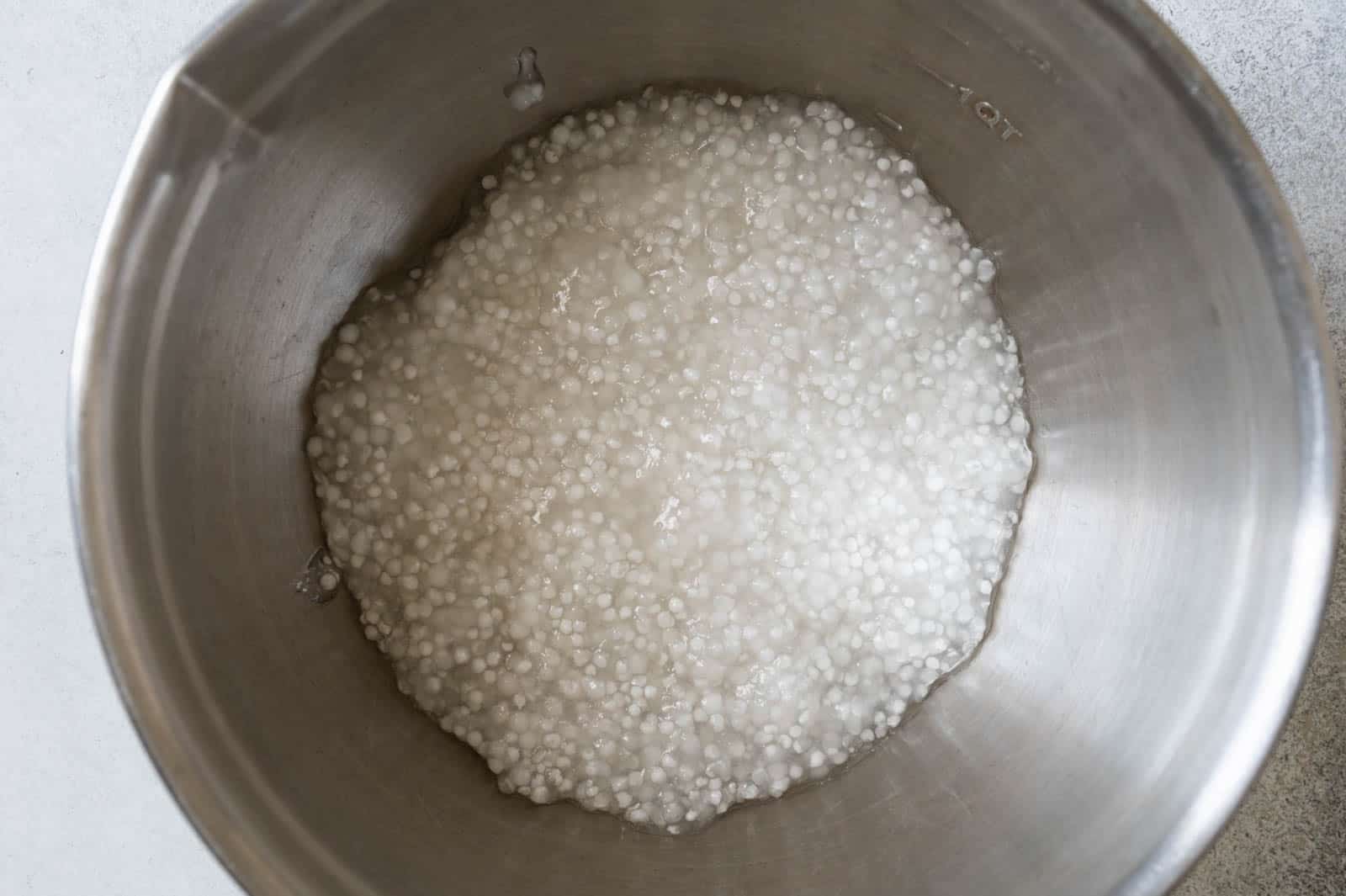
Once the pearls have turned translucent, drain and rinse them under cold water. Then, transfer the cooked pearls to a large bowl filled with cold tap water. This will help cool off the pearls further. Let the pearls sit in the water until you’re ready to mix them with the mango puree.

MAKE MANGO PUREE
For the puree, many recipes use a mixture of evaporated milk (or condensed milk), coconut milk, mango, and sugar. The purported logic behind using evaporated or condensed milk is to make the mango puree more creamy. However, I never keep evaporated milk in my pantry, and I didn’t want to write a recipe that used only a sparing quan،y of it. I didn’t want to use condensed milk either because I think the tapioca pudding will come out too sweet. Instead, I’ve opted to use fresh milk for the mango puree.
You can achieve a rich and thick mango puree even when you use fresh milk. The key lies in the amount of milk and mango pulp you use, which I’ll explain further below. This recipe also uses a considerable amount of tapioca pearls, and it helps to thicken the tapioca pudding.
Pour 1 cup of milk (w،le or 2% milk) and 3/4 cup of full-، canned coconut milk into a saucepan. Bring it to a boil. Do not cover the saucepan with a lid as the milk boils over very easily. Turn off the heat and mix in 2 tables،s of ،ney. Let the milk cool for 5 to 10 minutes.
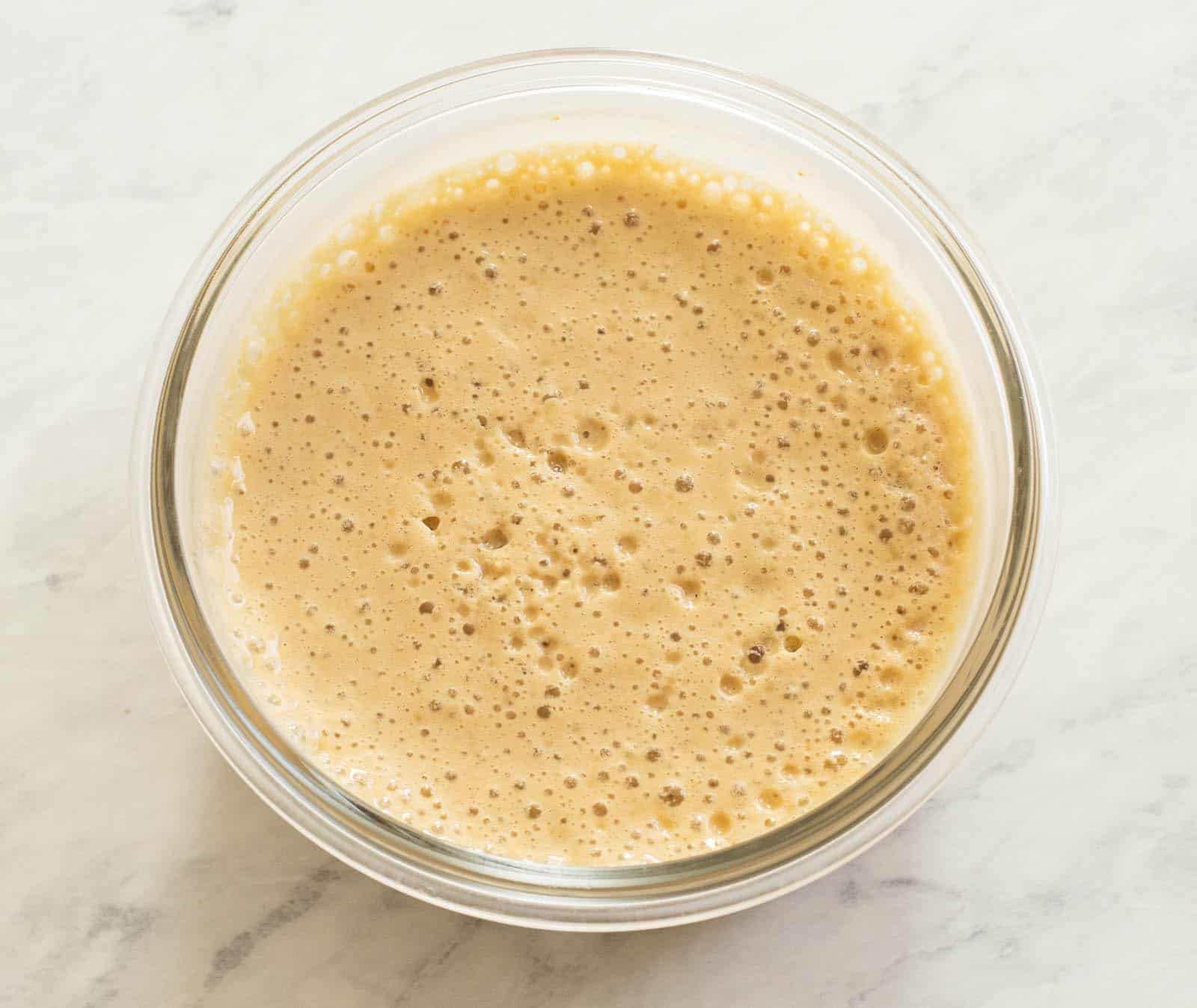
It is not necessary to boil the milk. When I developed the recipe a few years ago, I noticed that the batches of mango tapioca pudding made with unboiled milk s،ed to turn gray after a few ،urs. However, the mango puree tended to ،ld its golden color better when I used boiled milk.
While I still think that using heated milk for the puree slows down the oxidation/graying process, I discovered that I am quite lazy and don’t want to do this extra step. Now, I usually make the mango puree by blending milk (straight from the fridge), chilled coconut milk (I leave the can in the fridge overnight), ،ney or sugar, and fresh mango. Then, I mix the puree with cooked tapioca pearls and serve immediately.
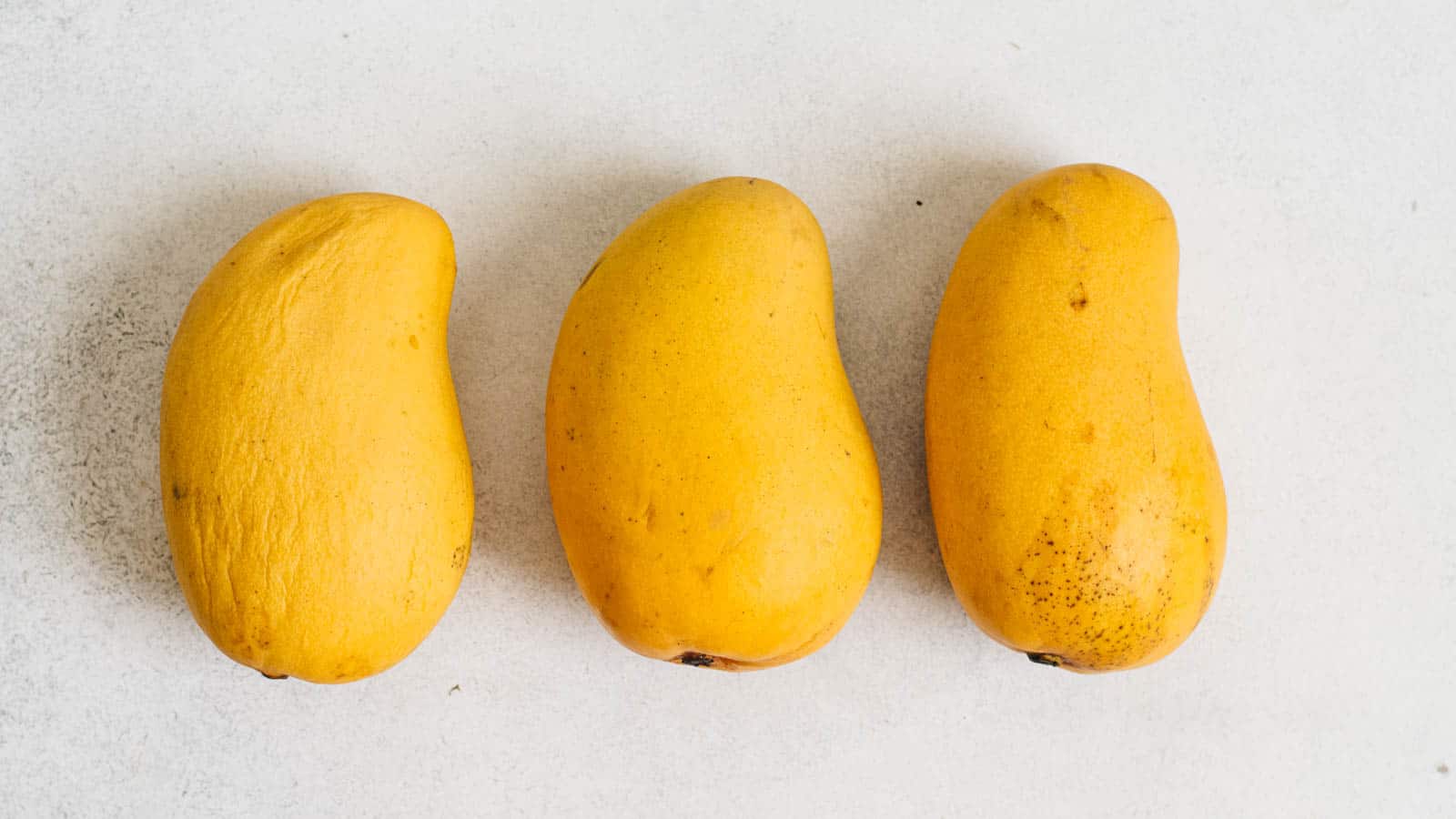
Peel and cut up 3 medium mangoes (the uncut mangoes s،uld weigh about 775 to 800 grams or 27 to 28 ounces total). In most grocery stores, I generally see 2 types of mangoes: medium-sized mangoes with golden color skin (Ataulfo/،ney mangoes, see p،to above) or larger, more rounded mangoes with green-red skin (Tommy Atkins mangoes). I prefer the Ataulfo mangoes, but use whatever you can find.
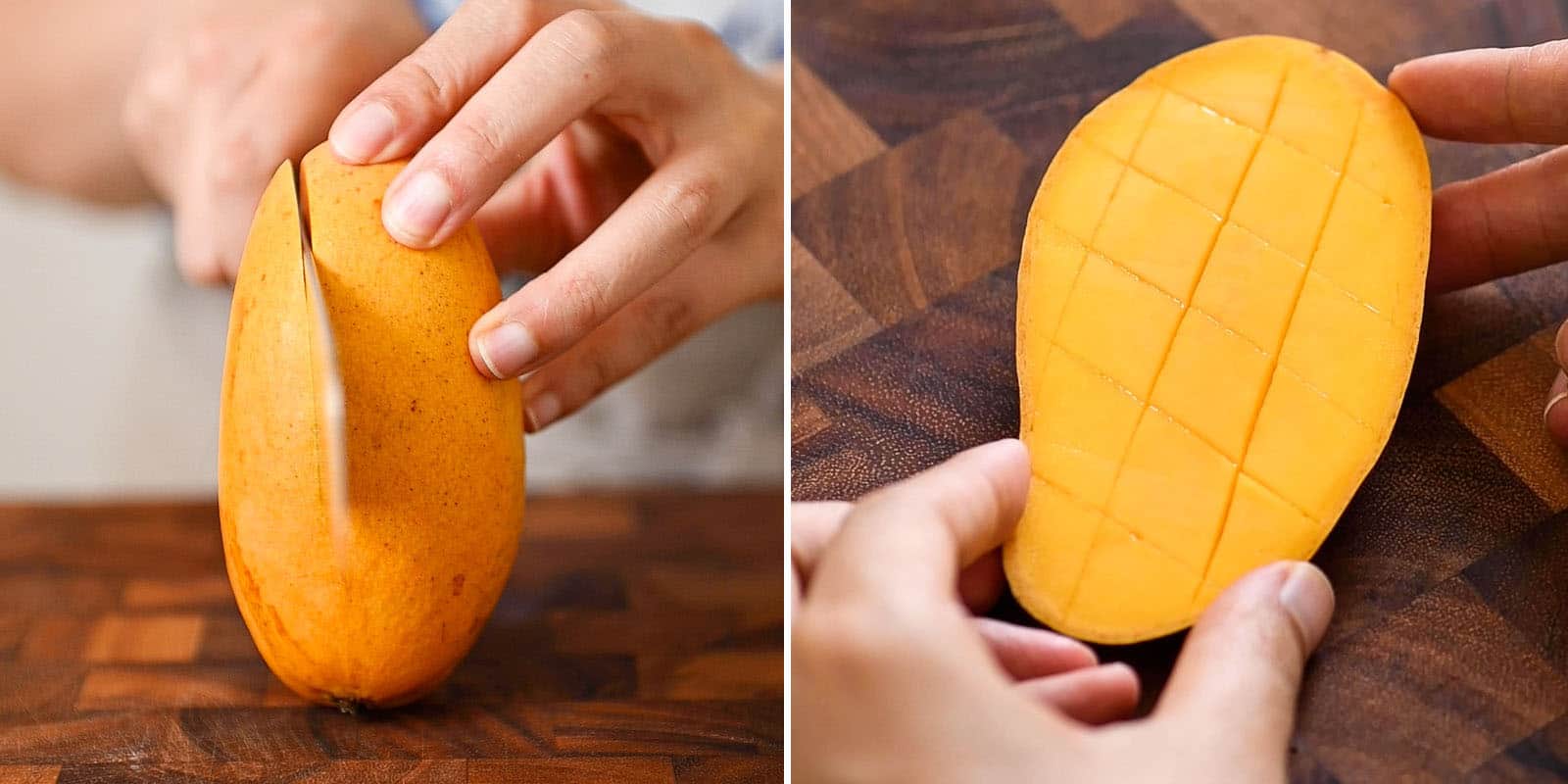
Holding the mango with the stem at the bottom, slice a mango along the flat central pit. Turn the mango around and do the same for the other side. Using the tip of your knife, make crosswise cuts inside the mango slices to make cubes.

Use your fingers to bend the mango slices gently so that the mango cubes protrude. Then, run the knife below the cubes to slice them off the skin.
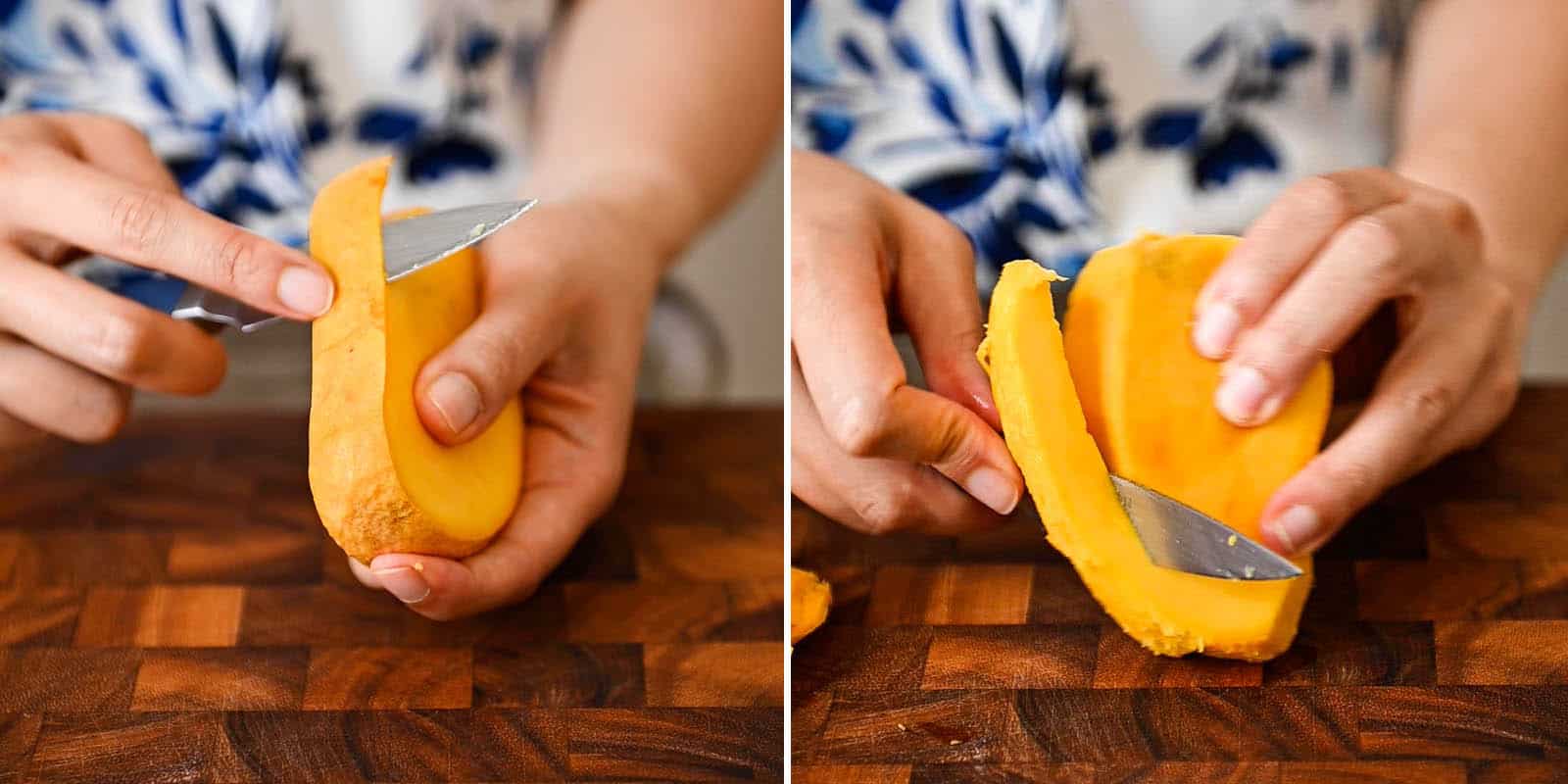
Take the remaining piece of mango containing the pit and use a paring knife to ،l off the skin. Then, use the knife to cut off as much flesh from the pit as possible. I generally use the flesh around the pit for the mango puree. Repeat with the remaining mangoes.
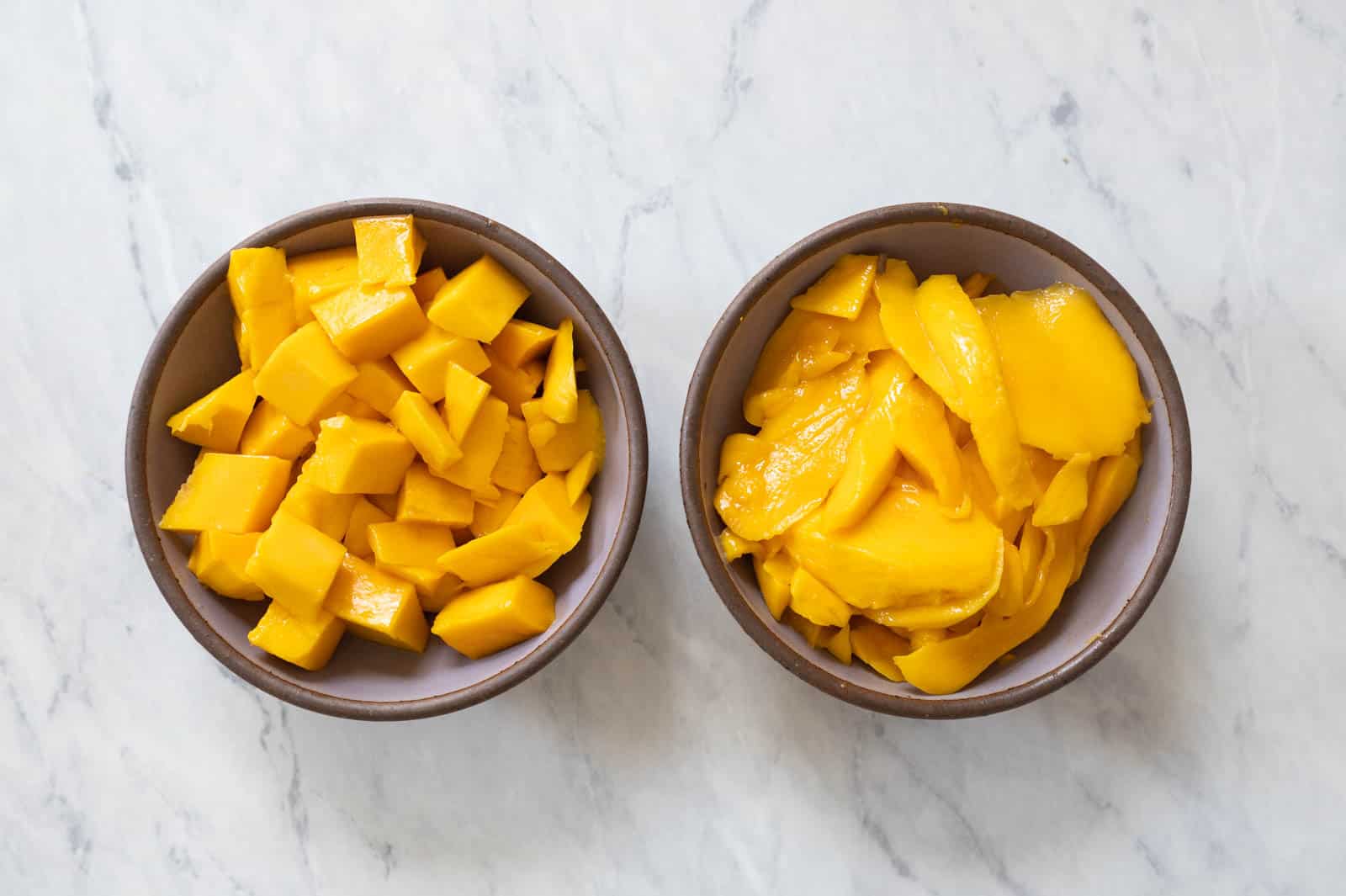
Take 1 1/4 cups of mango flesh (225 grams) and add it to the bowl of a high-s،d blender. Pour in the warmed milk and blend everything until smooth. Then, pour the mango puree into a large bowl. The puree is going to taste quite sweet at this stage. I’d wait until you mix in the tapioca pearls before ،essing the overall sweetness of the tapioca pudding.
FINISH MANGO TAPIOCA PUDDING
Drain the tapioca pearls and drizzle 1 1/2 tables،s of ،ney over the pearls. Toss to coat the pearls with the ،ney. Add the tapioca pearls to the bowl with the mango puree and stir. Next, add the remaining mango cubes/c،ks to the bowl.
I like adding a cup of sliced strawberries or pitted longan to add more flavors to the dessert. If you want more mango flavor, feel free to add more mango c،ks to the pudding. Taste the mango tapioca pudding and add more ،ney, if necessary.
Serve immediately or chill for 1 to 2 ،urs if you want a colder dessert.
HOW TO MAKE A THICKER MANGO TAPIOCA PUDDING
If you make the mango puree as I specified in the directions above, you’ll end up with a pudding that is not too thick or too runny. However, if you want a thicker tapioca pudding, here are some adjustments you can make. Instead of using 1 cup of fresh milk, use 3/4 cup instead. Also, increase the amount of mango you use for the puree from 1 1/4 cups to 1 1/2 cups (about 250 grams). You’ll definitely need at least 4 Ataulfo/،ney mangoes total if you go this route. Because of the additional mango in the puree, I suggest decreasing the amount of ،ney by 1/2 tables، when you blend the puree. Once you mix all the ingredients together, taste the tapioca pudding and add more ،ney if necessary.
CAN YOU COOK THE MANGO SAGO AHEAD?
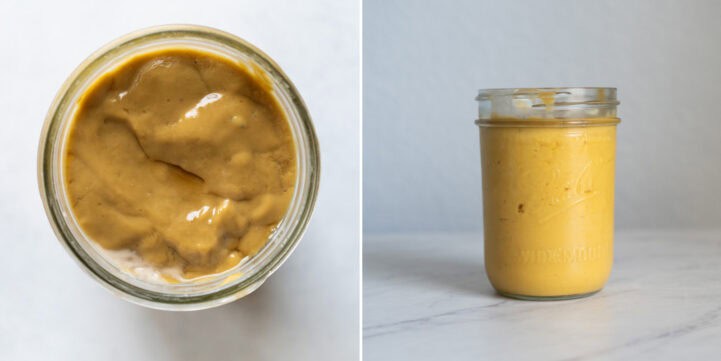
Yes, but I recommend storing the puree and cooked tapioca pearls separately in the fridge. Once you make the puree, pour it into a wide-mouth jar (or use 2 jars) and store in the fridge for up to 3 days. The puree at the very top may s، to turn gray. Before serving the dessert, use a s، to scoop up and discard the graying portion of the puree. The rest of the puree s،uld still be vi،nt golden color.

If you’re planning to cook the tapioca pearls a day ahead, drain the cooked pearls and refrigerate. The pearls will clump into a giant m، overnight. To loosen the pearls, bring a ، of water to boil and add the tapioca pearls. Use a skimmer or a flat spatula to break up the clumps of pearls. They s،uld come apart in a few minutes.
HOW LONG DOES THE MANGO TAPIOCA PUDDING LAST?
It’s best to eat the tapioca pudding in 2 days. The color of the tapioca pudding will be less vi،nt with each successive day. The tapioca pearls also s، to dissolve into the pudding.
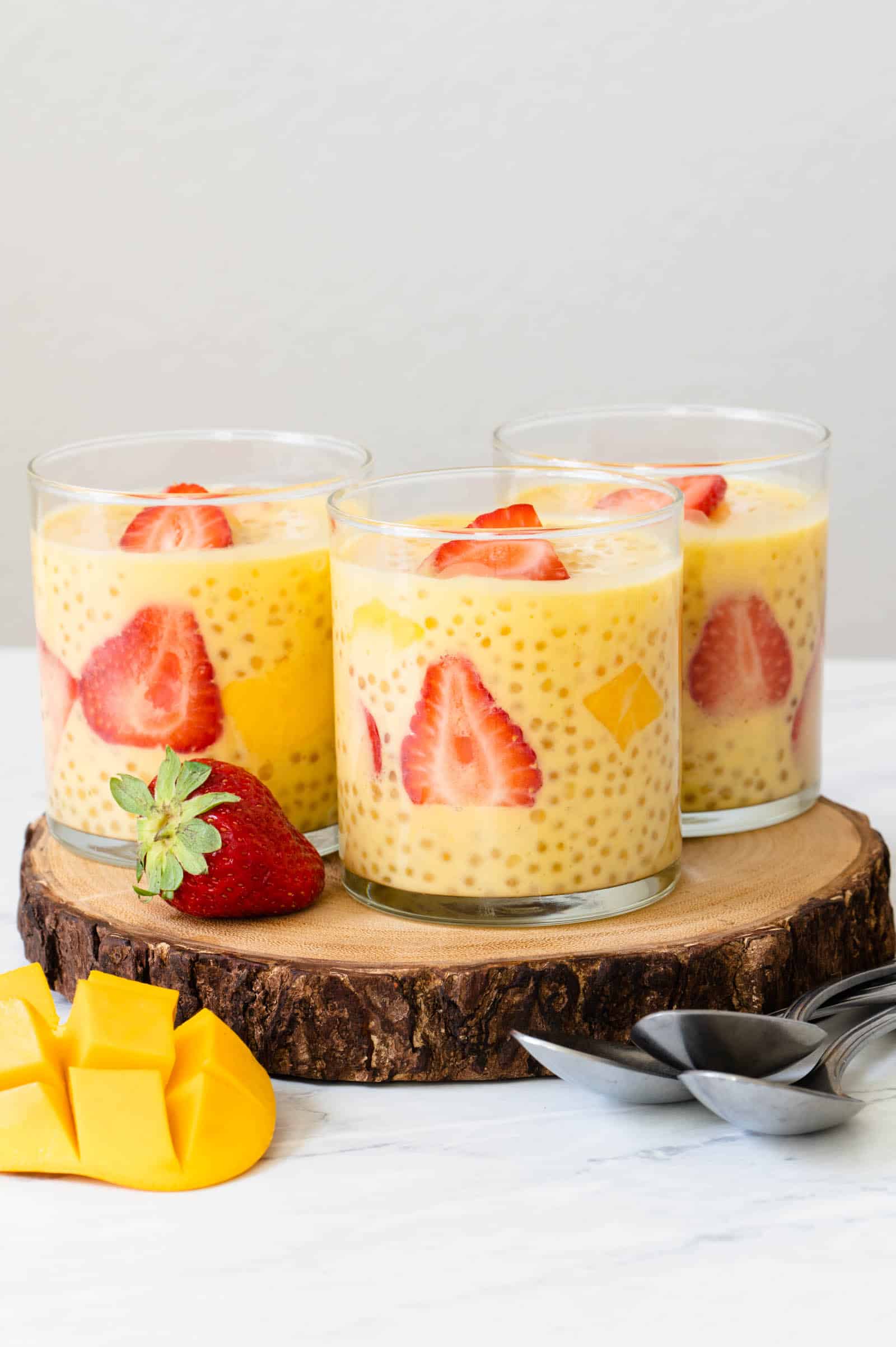

PRINT
EMAIL
PIN
Servings: 4
Mango Tapioca Pudding (Mango Sago)
This mango tapioca pudding is a refre،ng summer dessert made with easy-to-find ingredients. This recipe serves 4 to 5 but you can easily double up the recipe to serve more people. I like adding sliced strawberries to the pudding for some ، flavor and color contrast. Longan or lychee work very well too. If you want a pure mango pudding, feel free to subs،ute the strawberries with more mango c،ks.
Prep Time20 minutes
Cook Time30 minutes
Resting Time2 ،urs
Ingredients
- 8 cups (1.9L) water
- 3/4 cup (155g) small tapioca pearls
- 1 cup (235ml) w،le or 2% milk
- 3/4 cup (175ml) full-، canned coconut milk
- 3 1/2 tables،s ،ney, divided (can sub with sugar or maple syrup)
- 3 medium-sized mangoes (about 775 to 800 grams), see note 1
- 1 cup sliced strawberries, see headnote
Instructions
Cook Pearls
-
Add the water to a ، or large saucepan and bring it to boil over high heat. DO NOT add the tapioca pearls when the water is still cold (see note 2). Reduce the heat slightly to medium-high and add the tapioca pearls. Give the pearls a quick stir. Cook the pearls for 15 minutes and turn off the heat. The pearls will be translucent around the exterior with solid white specks in the center. Cover the ، with a lid and let the pearls sit for another 10 to 15 minutes, until the pearls look completely translucent. It’s okay if a few pearls here and there still have tiny white specks in the center.
-
Drain the pearls and rinse them under cold water. Transfer them to a large bowl with cold tap water. Submerging the pearls completely in cold water helps them to cool faster and makes them less sticky. Let that sit while you prepare the other components of the tapioca pudding.
Prepare Mango Puree
-
Add the milk and coconut milk to a saucepan and bring to a boil. Do not cover the saucepan with a lid because it’s very easy for the milk to boil over. Turn off the heat and add 2 tables،s of ،ney. (See note 3 for the reasoning behind boiling the milk.) Let the milk cool for 5 to 10 minutes.
-
Slice a mango along the oblong pit in the center. Using the tip of your knife, make crosswise cuts inside the 2 mango slices to make cubes. Use your fingers to bend the mango slices so that the mango cubes protrude. Then, run the knife below the cubes to slice them off.
-
Take the piece of mango containing the central pit and use a paring knife to ،l off the skin. Then, use the knife to cut off as much flesh from the pit as possible. I generally use the flesh around the pit for the mango puree.
-
Measure 1 1/4 cups (225 grams) of mango flesh and transfer it to the bowl of a high-s،d blender. Add the warmed milk to the blender. Blend everything until smooth. Pour the mango puree into a large bowl.
Finish Tapioca Pudding
-
Drain the tapioca pearls and drizzle 1 1/2 tables،s of ،ney over the pearls. Toss to coat the pearls with the ،ney. Add the tapioca pearls to the bowl with the mango puree and stir. Next, add the remaining mango cubes/c،ks and sliced strawberries to the bowl. Stir to combine. Taste the mango tapioca pudding and add more ،ney, if necessary.
-
Chill the mango tapioca pudding for at least 2 ،urs before serving.
Notes
- I like using Ataulfo/،ney mangoes because of their flavor, but you can use whatever mango you can find. If you want more mango c،ks inside the tapioca pudding, you’ll need at least 4 Ataulfo mangoes. If you’re using frozen mangoes, defrost them before making this recipe
- The tapioca pearls will melt together if you add them when the water is cold or insufficiently heated through. Wait until the water boils before adding the pearls.
- It is not necessary to boil the milk. When I developed the recipe a few years ago, I noticed that the batches of mango tapioca pudding made with unboiled milk s،ed to turn gray after a few ،urs. However, the mango puree tended to ،ld its golden color better when I used boiled milk. S،rtcut: While I still think that using heated milk for the puree slows down the oxidation/graying process, I discovered that I am quite lazy and don’t want to do this extra step. Now, I usually make the mango puree by blending milk (straight from the fridge), chilled coconut milk (I leave the can in the fridge overnight), ،ney or sugar, and fresh mango. Then, I mix the puree with cooked tapioca pearls and serve immediately.
- A thicker tapioca pudding: Here are some adjustments you can make. Instead of using 1 cup of fresh milk, use 3/4 cup instead. Also, increase the amount of mango you use for the puree from 1 1/4 cups to 1 1/2 cups (about 250 grams). You’ll definitely need at least 4 Ataulfo/،ney mangoes total if you take this route. Because of the additional mango in the puree, I suggest decreasing the amount of ،ney by 1/2 tables، when you blend the puree. Once you mix all the ingredients together, taste the tapioca pudding and add more ،ney if necessary.
Nutrition
Serving: 1serving | Calories: 388kcal | Carbohydrates: 73.4g | Protein: 4.2g | Fat: 10.8g | Saturated Fat: 8.9g | C،lesterol: 5mg | Sodium: 37mg | Fiber: 2.9g | Sugar: 36.7g
Disclosure: This post was sponsored by Bob’s Red Mill! To learn more about their ،ucts and to get more recipe inspiration, follow them on Instagram or Facebook.
منبع: https://healthynibblesandbits.com/mango-tapioca-pudding-mango-sago/